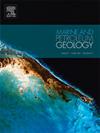Depositional and diagenetic evolution of the Lower Eocene homoclinic-ramp carbonates (a paradigm from the Salt Range, Pakistan): Sequence stratigraphic, petrographical, diagenetic, and geochemical attributes
IF 3.7
2区 地球科学
Q1 GEOSCIENCES, MULTIDISCIPLINARY
引用次数: 0
Abstract
Despite the economic significance of the lower Eocene carbonate of the Nammal Formation as a hydrocarbon resource, the influence of depositional facies and diagenetic sequences on the Nammal reservoir quality remains limited. A study on the sedimentological, sequence stratigraphic, diagenetic, and geochemical attributes of the Nammal carbonates has been carried out in three surface sections: Nammal section (NS), Sethi section (SS), and Mustafabaad section (MS). To achieve the study target, various petrographic analyses of samples, geochemical analyses (X-ray diffraction (XRD) and X-ray fluorescence (XRF)), and petrophysical measurements (i.e., porosity and permeability) have been intergrated in this study. Our analysis unveils that the Nammal Formation contains mainly alternating marl, shale, and limestone beds. The facies distribution in the middle and upper parts of the Nammal Formation predominantly comprises larger benthic foraminifera, for instance, nummulitids (Nummulites and Assilina), discocyclinids, and rare alveolinids, which demarcate a deepening upward sequence or fining-upward depositional trend. The distribution of these facies is extended from the west to the central parts of the Salt Range, and it is marked as a condensed section in the middle parts of the formation overlain by shallower strata. The upper part of the formation is characterized by a shallowing-up sequence, as there are assemblages of nummulitids, alveolinids, and shallower fauna that extends towards the eastern parts of the Salt Range. The sedimentological analysis of the Nammal Formation depicts the identification of nine microfacies of four recognizable facies associations, revealing the deposition of the Nammal Formation in variable low-to high-energy carbonate ramp sub-environments, including carbonate lagoons to barrier/shoals, open marine, and deep open marine settings. The Nammal Formation represents the transgressive system tracts (TST) of the Early Eocene carbonate sequence, reflecting carbonate deposition during the rise in sea level in the form of a retrogradational depositional trend of the shallowing upward facies. The Nammal Formation underwent a complex multi-stage diagenetic history taking place over a range of diagenetic settings, including shallow burial, early Eocene uplift and erosion, and subsequent deep burial. Among the recorded diagenetic changes and processes (e.g., dissolution and fracturing) that improved the reservoir properties, others (e.g., cementation, micritization, mechanical and chemical compaction, and pyritization) reduced them by plugging the pore spaces and voids. The Nammal Formation is suggested to be a relatively tight reservoir based on the porosity and permeability values and the nature of compact carbonates. The studied Eocene carbonate deposits preserve carbonate analogues liable for allostratigraphic correlation, identical lithostratigraphic analogues, age constraints, and basin-wide geometrical resemblances. Comparisons of the examined sequence boundaries along the southern Tethys from India to Egypt and in global charts suggest that eustatic and geological effects were relatively simultaneous.
求助全文
约1分钟内获得全文
求助全文
来源期刊

Marine and Petroleum Geology
地学-地球科学综合
CiteScore
8.80
自引率
14.30%
发文量
475
审稿时长
63 days
期刊介绍:
Marine and Petroleum Geology is the pre-eminent international forum for the exchange of multidisciplinary concepts, interpretations and techniques for all concerned with marine and petroleum geology in industry, government and academia. Rapid bimonthly publication allows early communications of papers or short communications to the geoscience community.
Marine and Petroleum Geology is essential reading for geologists, geophysicists and explorationists in industry, government and academia working in the following areas: marine geology; basin analysis and evaluation; organic geochemistry; reserve/resource estimation; seismic stratigraphy; thermal models of basic evolution; sedimentary geology; continental margins; geophysical interpretation; structural geology/tectonics; formation evaluation techniques; well logging.
 求助内容:
求助内容: 应助结果提醒方式:
应助结果提醒方式:


